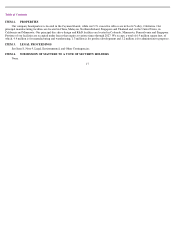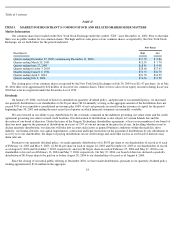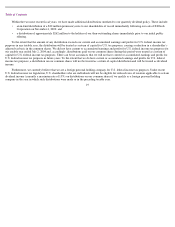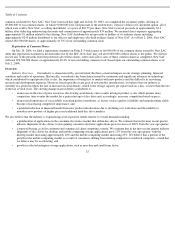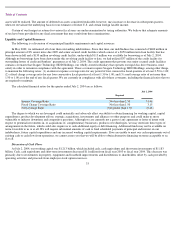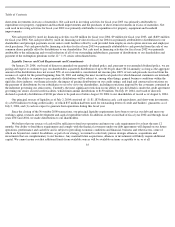Seagate 2003 Annual Report Download - page 27
Download and view the complete annual report
Please find page 27 of the 2003 Seagate annual report below. You can navigate through the pages in the report by either clicking on the pages listed below, or by using the keyword search tool below to find specific information within the annual report.
Table of Contents
In the first half of fiscal year 2004, we observed what we believe to be a shift in seasonal demand for disc drives used in desktop and
consumer electronics markets. We believe the seasonally high demand for disc drives used in these markets may be shifting more toward our
first fiscal quarter from our second fiscal quarter. We believe this trend will continue and, due to the increasing importance of the consumer
electronics market to our business, will impact our revenue and results of operations in these quarters.
Another key factor is the continued importance of sales to the distribution channel. Product qualification programs in this channel are
limited, which increases the number of competing products that are available to satisfy demand, particularly in times of lengthening product
cycles. As a result, purchasing decisions in this channel are based largely on price, terms and product availability and unit sales growth is less
predictable and has greater fluctuation than sales to OEM customers. To the extent that our industry builds product based on expectations of
demand that do not materialize, distributors may experience an oversupply of personal storage products that could lead to increased price
erosion. As sales to distributors become an increasingly larger portion of total industry sales, disc drive manufacturers may experience
increased volatility in their results of operations.
Seagate Overview. We maintain a highly integrated approach to our business by designing and manufacturing components we view as
critical to our products, such as read/write heads and recording media. We believe that our control of these key technologies, combined with
our innovations in manufacturing, enable us to achieve product performance, time-to-market leadership and manufacturing flexibility, which
allows us to respond to customers and market opportunities. Although we derive an important competitive advantage as a result of this strategy,
it results in higher fixed costs, which may adversely affect our financial performance, particularly in periods of declining demand and in
periods of slower growth in the areal density curve such as we are now experiencing. To offset these higher fixed costs we are continuously
engaged in efforts to reduce our costs and improve our manufacturing efficiencies and flexibility. This approach also increases the importance
of realizing and maintaining substantial market share in the markets in which we compete, allowing us to spread our technology investments
across a high unit volume of products.
A significant portion of our success historically has been a result of increasing our market share at the expense of our competitors.
However, in the first fiscal quarter of 2004, our market share for our enterprise products was negatively affected by our customers’
diversifying
their sources of supply as the slowing areal density curve has resulted in longer product cycles and more time for our competitors to enter the
market for particular products. Additionally, in the second half of fiscal year 2004, our market share for notebook drive products was
negatively affected by an oversupply condition in our customers’ supply chain. During June 2004, however, we announced 12 new products,
which will address every major computing application and all major consumer markets thereby expanding our current addressable market from
approximately 75% to approximately 97%. We believe that our near-term financial results will depend heavily on the successful introduction
and customer acceptance of these new products.
We are dependent on our sales to distributors, however, in the distribution channel unit sales growth is less predictable and has greater
fluctuation than sales to OEM customers. To the extent that our industry builds product based on expectations of demand that do not
materialize, distributors may experience an oversupply of personal storage products that could lead to increased price erosion. During our
second fiscal quarter of 2004, ended January 2, 2004, we observed lower than anticipated sell-through in the distribution channel. We believe
our experience was consistent with that of our industry. We believe that this lower than anticipated sell-through taken together with the level of
industry production, created increased pressure on pricing and terms and resulted in historically high industry channel inventories at the end of
the December quarter. During the March quarter, a number of disc drive manufacturers independently launched initiatives to improve the
stability of the distribution channel, particularly with respect to the purchasing behavior of distributors while other disc drive manufacturers
have not. These initiatives included efforts to develop point-of-sale information systems to help match supply and demand, pricing increases
and alteration of distribution programs. As the distribution channel reacts to these various activities, there may be increased volatility of sales in
this channel for individual disc drive manufacturers. We exited the June quarter with approximately 5 weeks of distribution channel inventory,
or
26



